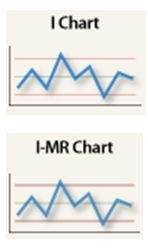It’s common to think that process improvement initiatives are meant to cater only to manufacturing processes, simply because manufacturing is where Lean and Six Sigma began. However, many other industry segments, such as healthcare and banking, also rely on data analysis and Lean Six Sigma tools to improve processes (even if those processes are more service-based).
For example, it’s increasingly common for healthcare professionals to conduct projects to help them investigate and understand certain clinical outcomes for patients, such as the incidence of a certain disease developing after surgery. And in the financial industry, there’s an increased focus on improving internal procedures, such as the processing of customer payments.
Here are a couple interesting uses of Minitab Statistical Software outside of manufacturing that I’ve come across in recent conversations with customers.
Preventing Pressure Ulcers
 Pressure ulcers, or bed sores, can be inflicted upon hospital patients who must stay in bed for a long period of recovery time. The ulcers can cause further injury to patients, as well as impact the length of stay and cost of care.
Pressure ulcers, or bed sores, can be inflicted upon hospital patients who must stay in bed for a long period of recovery time. The ulcers can cause further injury to patients, as well as impact the length of stay and cost of care.
As part of an initiative to eliminate preventable harm to its patients, one large hospital system planned an improvement effort to lessen the incidence of hospital-acquired pressure ulcers.
To identify which hospitals in the system should be the focus for improvements, practitioners created a Pareto chart in Minitab to show the frequency of pressure ulcer occurrence across the system. They were able to conclude that a large percentage of all pressure ulcers were occurring in four of the ten hospitals.
To drill down even deeper, they followed up with another Pareto chart to help identify which units within the hospitals had the highest incidence of pressure ulcers. The Pareto Charts helped the hospital system understand their situation, which made it easy for them to develop a targeted solution and implement it.
Understanding Volume of Customer Payments
Occasionally, large business customers who borrow money from major financial institutions  become concerned that their payments are not being processed on the day they are received. These payments are larger dollar values (read – much, much higher than our typical monthly home mortgage payments and are paid much more frequently), and the customers want to be sure their payments are being processed in a timely fashion and their accounts are being updated correctly.
become concerned that their payments are not being processed on the day they are received. These payments are larger dollar values (read – much, much higher than our typical monthly home mortgage payments and are paid much more frequently), and the customers want to be sure their payments are being processed in a timely fashion and their accounts are being updated correctly.
When this occurs, the institution can show the customer graphically their historical volumes of payments over time. With control charts in Minitab, the institution can illustrate the customer’s influx of payments processed for each day of the week over the course of a year. The charts can show them what “normal” really is for their volume of payments – and they are often amazed by the variation!
Learning from Others
Learning about the use of quality improvement tactics across different industries can introduce you to new tools or methods that also might work well for your business. For example, I was recently at a conference where a session described how one hospital identified gaps in patient safety using the same best practices employed by federal and international aviation administrations to keep passengers safe.
To read how Minitab customers from across a multitude of industries have solved problems and improved quality, check out our Case Studies page.
Do you work in an industry outside of manufacturing that also uses process improvement techniques?



